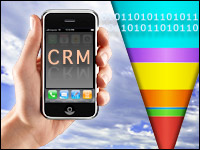
Siebel saved my life. Not really but sort of. By the early 1990s, I had been selling software for what seemed like a lifetime and dealing with the typical frustrations of life in sales. There weren’t enough leads, and there was always more work to do than you could squeeze into a day. I kept records on legal pads and file folders, and I had a Rolodex that I would never update because it was way too much work. And then there was forecasting.
Fortunately, I was young and gifted with a great memory, so I could remember everything that was relevant in a deal. Beginning in the 1980s I had worked for a succession of DEC partners and I found that I could memorize whole catalogs — VAX and PDP-11 were separate — without trying.
But, yes, Siebel saved my life because by the early 1990s, I was burned out. The mini-computer boom was fizzling, the dot-com boom had not yet started, and there was a recession that made everyone skittish about installing systems on PC networks because they were also skittish about network operating systems.
Finding leads was hard. No one would spend much on marketing, and bingo card leads were of such low quality that it was easy to return them to marketing with a heavy dose of scorn. Cold calling was a way of life. There was no Internet to speak of, and researching prospects was tedious. The early market euphoria in which every company was a prospect had given way much too quickly to a war of attrition.
Plenty of Respect but No Love
I was not a Siebel user, but it nevertheless saved my professional life because it showed there was a better way to sell that didn’t involve dialing till you dropped, unmanageable paper records, and monthly forecasts — little fictions whose greatest quantitative attribute was that they were rendered in spreadsheets.
Siebel wasn’t even the first tool of its kind. ACT! and Goldmine were already on the market, but Siebel took what had been a single user experience and made it germane to selling in the enterprise.
It would still be many years after Siebel’s founding before we would see integrated marketing and customer service — but true to form, Siebel was one of the leaders in consolidating the CRM suite at a time when public companies would buy other companies in simple swaps using their stocks like cash.
Siebel also hired aggressively. EVP David Schmaier would routinely visit his alma mater, Harvard Business School, each spring and round up its best and brightest for export to San Mateo. As a strategy it worked reasonably well, and the company was always awash with smart, talented people — not just the Harvards, by the way.
Many of them are still in The Valley, populating other companies including Oracle, where some settled after the buyout. Today having Siebel on your resume is akin to having Oracle or HP back in their heydays. It says you were first, you were prescient, you’re a survivor.
The company was never loved, in my estimate, and that is a key lesson for all those who come after. Siebel played by a script that was pure Geoffrey Moore — not that Moore is like that, I don’t know him.
However, in Crossing the Chasm, Moore set down some absolute truths about how paradigms shift and how the eventual winners conduct themselves. Early markets are take-no-prisoner ground acquisition games.
Capture as much territory as you can to deny it to your competitors; deal in a general-purpose product and accept customization ideas with great reluctance and great cost; expect the customer to figure it out and provide adequate but no-frills support, because most of your energy is dedicated to capturing more, more, more.
It was a brilliant strategy that some might say was invented at Oracle, so it was only common sense that Tom Siebel and several other titans of today’s software landscape would come out of that culture. The strategy has a down side too, though. As I say, Siebel may have been respected for its execution, but I doubt if it was ever loved in the way that Apple was loved, for instance.
The lack of love made it easier to accept the assertions of an upstart analyst firm at the time: that Siebel’s marquee customers could not show an ROI. A scandal erupted that took a good deal of wind out of the company’s sails. Then, too, half of all CRM efforts would fail, a Gartner analyst famously forecasted in off-the-cuff remarks. Many people grasped at these factoids like they were drowning.
Shades of Gray
If all you read are the headlines, then your world is rather black and white, but if you delve just a bit deeper you understand that the world is rather gray, and this situation was no exception. Frustrated by the charges that the company believed were bogus, Siebel hired me to evaluate not the charges but its customer base. My partner at the time was fellow Aberdeen analyst Harry Watkins, who happened to hold a Ph.D. in marketing and also taught at the university level.
Our work was clean. We were separated from Siebel by 3,000 miles and given broad latitude to question its customers. What we discovered in many cases was exactly what Geoffrey Moore might have predicted. Major corporations had bought Siebel because it was the market leader and because they didn’t want to lose a step to a competitor. They were early adopters after all.
The result was that a whopping half of the customers never bothered to conduct even a rudimentary needs analysis before or after purchase, our research showed. Many could not quote an ROI because they had no relevant starting point for comparison.
In a great bit of statistical analysis, Watkins discovered that some of the companies that were reporting ROI numbers were among those that failed to perform that needs analysis. When he compared this group with those who had actually performed needs analyses, he found that in aggregate, the faux reporters had lower ROI to report.
Our conclusion was that without a valid starting point for ROI, the faux reporters either developed amnesia about how bad things had been prior to implementation or they’d downplayed their results so as not to contradict the evident truth of the herd and the headlines.
Burned Brightly
When we published the results, a few people in the industry whom we had thought of as friends demanded our heads on platters. It was all good fun — but that’s not the whole story. In direct follow-up interviews with some customers, we discovered additional truths. Siebel really was hard to use, especially for people who had never followed organized business processes, and organizing sales people of that era was like rustling cats.
Using its client-server architecture, the most advanced for the times, required a great deal of handholding. One major company I spoke with had three teams of technologists dedicated to Siebel — one each for the last release, the current release and the next one. They were tired — but curiously, not angry.
Siebel had the lifecycle of a meteor — a bright youth and an ignominious end. In subsequent years, relative newcomer Anthony Lye would do much to integrate Siebel into Oracle and flesh out the product line with a SaaS architecture and many auxiliary functions — other free standing companies bought with Oracle cash to fill out the very complete suite we see today.
Siebel got started in 1993, which means this is the 20th anniversary year of its founding. A lot has happened in the interim. Siebel is no longer a standalone entity, having been acquired in a greater version of stock market brinkmanship than even it had participated in during its growth phase.
In many ways, though, Siebel still is the market. Go into a Global 2000 company and you will see a Siebel system; today Salesforce users might flank that system’s users too. For many of these companies, Siebel is a workhorse system that has been through some of the wars and continues to be serviceable.
However, markets and vendors are changing. Oracle has Fusion and is slowly merging it with Siebel, while Salesforce continues to be the juggernaut that prematurely challenged Siebel in a joust of jests. If you follow Bruce Daley’s recent survey work, the customer base is in good shape, so you might wonder what’s next.
Customers seem to genuinely like Siebel these days, a good omen for sure. But current mainframers still love their big iron too. For all that, however, we aren’t building and selling mainframes very much and the installed base is shrinking — if only because COBOL/CICS programmers want to retire, and kids in school today don’t want to be big iron museum docents.
So where is Siebel at 20? Somewhere in middle age. There might be a “Siebel” named product 20 years from now, but it will be very different from what we have today, which is very different from what we had 10 years ago. By and large, that’s a good thing. So happy birthday, Siebel.

























































Brilliant piece. Well written, insightful and surprising. My hat is off to you Denis.